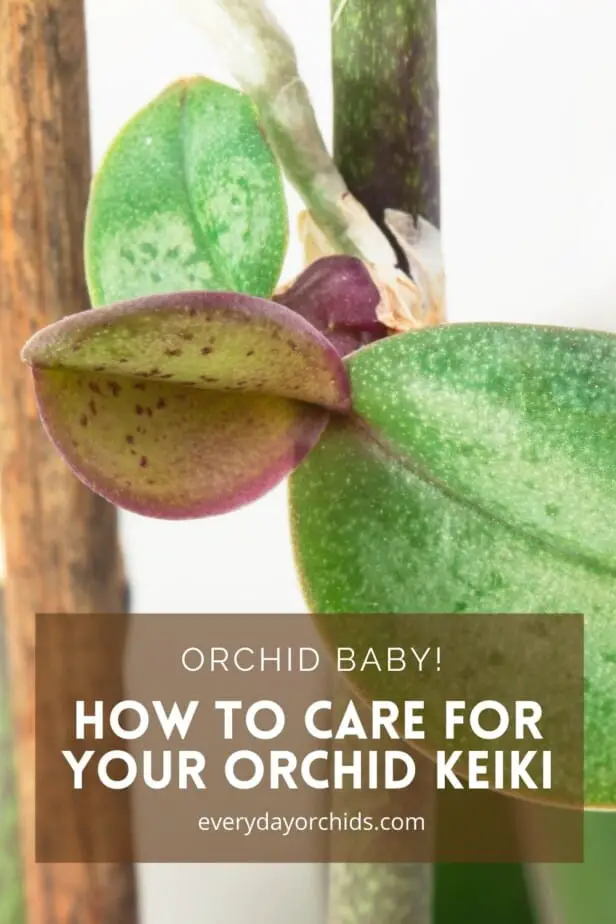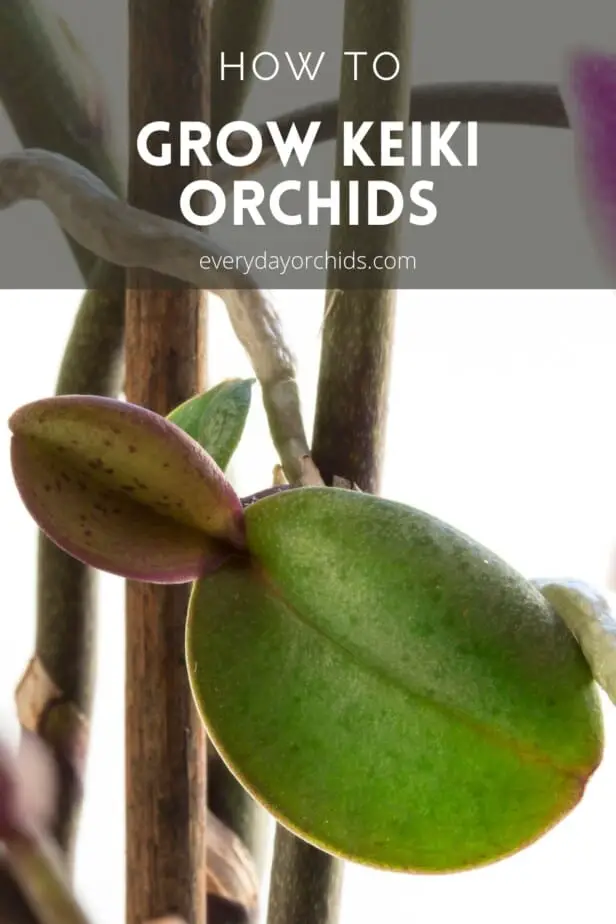If you are wondering how to take care of an orchid keiki, you have come to the right place. In certain growing conditions, your orchid may be able to sprout a keiki, otherwise known as a plantlet or a baby orchid plant. Phalaenopsis keikis grow from a node along the orchid’s spike. Dendrobium keikis sprout from the length of the cane or along the end of the Dendrobium cane. This baby plant is exactly like the mother plant genetically and sometimes will produce flowers while still attached to the mother orchid. Let’s talk about how to take care of these orchid keiki.

To care for an orchid keiki, wait for it to develop roots at least 2-inches long before you remove it from the mother plant. Replant the keiki and attached cut spike. Use nutrient-rich orchid potting media, mist the roots daily, and monitor the temperature and humidity. Keep the orchid keiki indoors until it becomes more established, but otherwise care for it as you would with a regular orchid.
For an orchid grower, few things are more exciting than finding a keiki growing on your orchid. Proper maintenance and transplanting of your orchid keiki can produce, in time, a brand-new, full-grown orchid.
In this article, you will learn more about keiki orchids, including the proper way to separate the keiki from the mother and replant it. There are ways you can encourage your orchids to grow keikis too. I will go over these methods and provide some additional keiki growing tips.
Please note that these links are affiliate links and as an Amazon Associate, I earn from qualifying purchases. Purchases made through affiliate links in this post may generate commissions at no additional cost to you. Use this link for a discounted Amazon Prime trial. Thank you for your support!
Table of Contents
What Is an Orchid Keiki?

Maybe you are here because you noticed small sprouts around your orchid’s stems or spikes and are wondering what these are. These sprouts with roots are known as keikis. They are the beginning of another orchid plant.
Orchid growers love orchids because they can grow keikis and then sell them or give them away to friends and family members. Orchid keikis are baby orchids that grow from a mother orchid.
Are Orchid Keikis Normal?
Yes! Keikis are completely normal. Many orchids have excess growth hormones that need to find a place to sprout, resulting in the formation of keikis. However, if you are noticing a lot of keikis all over your orchid, you might be over or underwatering the plant. Minor hydration adjustments can make a world of difference. In the wild, keikis are found on quite a few orchids.
In fact, you can trigger your orchid to grow keikis as a method of orchid propagation. I will provide a step-by-step guide to encouraging keiki growth in orchids later in this article. Keep reading to learn more!
What Does Keiki Mean?
‘Keiki’ roughly translates to ‘baby’ in Hawaiian. Quite literally, keikis are the babies of the mother orchid and can grow into full adult orchids. Keikis are most commonly found on two very popular orchid varieties, Phalaenopsis and Dendrobium orchids. You can also find keikis on Epidendrum orchids.
Knowing how to grow keikis can be incredibly rewarding. It is also quite beneficial if you want to start an orchid business or fill your garden with orchids.
Should You Be Concerned if You See Keikis?
As mentioned earlier, keikis often form as a result of excess growth hormones in an orchid. While this is part of a natural process, it is not always good sign for the mother plant.
If you notice that keikis are continually growing on your orchid or the mother orchid looks dehydrated, this might be a red flag. It could be a sign that the keiki is absorbing most of the nutrients from the mother plant and the mother plant is dying.
In some cases, orchids sprout keikis as a way to preserve their life cycle. When orchids are nearing the end of their life due to disease or malnutrition, the orchid will produce a keiki. In this case, this last-ditch effort shows that your orchid is dealing with stressful conditions that are detrimental to their health.
Not every keiki is a bad sign. It is essential to monitor your orchid’s regular growth patterns. That way, you will know what is normal and not. There are plenty of reasons that keikis sprout, most of which are not bad. I will go over these reasons next.
Why Do Orchids Grow Keikis?
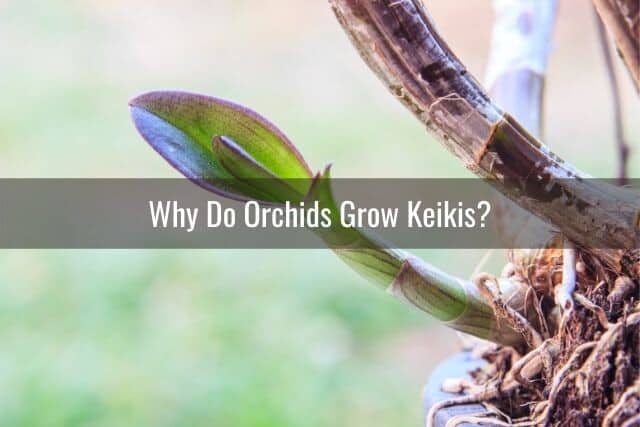
Excess hormones are only one of many reasons why keikis grow. If you are maintaining a healthy environment for your orchid, then there is a chance that healthy keikis will grow. It is not a sign that your orchid is in distress.
Why Orchids Grow Keikis
- Do all orchids grow keikis? No, not all orchids grow keikis, but many do. Phalaenopsis, Dendrobium and Epidendrum orchids are capable of growing keikis. This is important to keep in mind if you plan to grow and sell orchids as a business and want to intentionally grow keikis.
- Are keikis bad for orchids? Most keikis are not bad, but they are also not always expected. If your orchid looks dry, wilted, or discolored, the keikis could be a sign that your orchid is on its last legs. You could repot the orchid and provide new potting media. Check for any pest infestation or disease. You could also adjust the temperature and humidity and try to save the mother orchid. If you can manage to save the orchid, it will grow fewer keikis (or none).
- Can you plan keiki growth on your orchids? Yes you can! Using a plant hormone, you can grow keikis with a few simple steps. I will go over this process in more detail below. For now, keep in mind that you can grow keikis safely. Purposely dehydrating or malnourishing your orchid in an attempt to induce keiki growth is never a good idea.
- At what age can orchids grow keikis? Orchids can grow keikis at any age. However, if keikis sprout too early on in the orchid’s life, the keiki could steal all of the nutrients, ruining the mother plant. If you notice a keiki on a young orchid, you should safely remove the keiki and cover the wound with cinnamon powder. Cinnamon will prevent an infection or bacterial contamination.
- What causes orchids to grow keikis? Orchids sprout keikis as a result of malnourishment, dehydration, or excess growth hormones. Orchid keikis can also appear due to intentional growth (by following the steps I will outline below), or ideal growing conditions in specific genera. Identifying the cause is the best way to know what actions you should take.
Many orchid owners hope and pray for keikis, but there is a chance an orchid will never grow a keiki. Don’t be discouraged. As mentioned above, certain orchid species don’t grow keikis. A lack of orchid keikis could still mean that you are doing everything correctly and your plant is happy and healthy.
If you are set on getting keikis, you should make sure that your species is one of the orchid species can grow keikis. Then prepare your supplies and a secure location for the orchid to grow sprouts.
How to Encourage Keiki Growth on Your Orchid
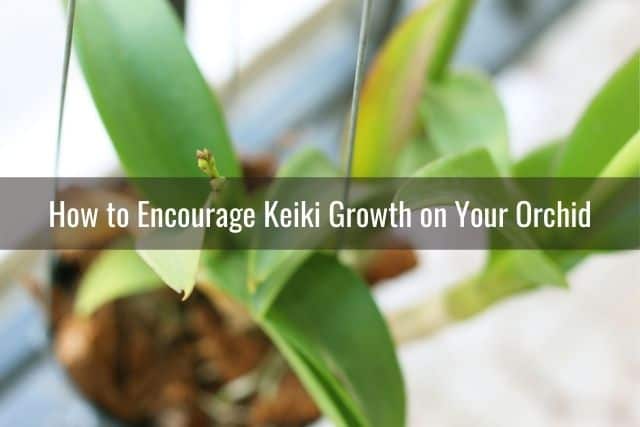
For those of you who want to grow keikis on your orchids, you are in the right place. I will go over this process in detail. Hopefully you will be able to grow keikis at home.
You actually do not need to spend a bunch of time, money, or effort to start the process. Instead, you can use store-bought plant growth hormones and a few other tools to encourage keiki growth. Some people prefer artificial supplements to expedite the process, so I will cover that too.
Steps To Grow Orchid Keiki
- Place the orchid in an humid environment. If the environment is too dry, keikis will not grow and the mother orchid will not thrive. You should already have a humidifier or adequate hydration for your orchids so this point should not be a surprise. Some people prefer to store the orchid in an enclosed container with damp sphagnum moss to promote extra humidity.
- Mist the orchid daily. Keikis use up a lot of nutrients and water. You should add extra moisture throughout the process. Mist your orchid and keiki roots daily with a spray bottle. Your orchids will absorb the water and grow keikis in the process. However, do not water them more than you would with a mature orchid.
- Use stem cuttings to propagate new orchids. If your orchid has a healthy stem or flower spike that is at least 10 to 12 inches long, you can use this to make stem cuttings. With a sharp sterilized knife or scissors, cut the stem from the orchid just above a node. Then proceed to cut the stem into sections, making sure that you leave at least two nodes per section.
Treat the cut ends with an anti-fungal powder such as cinnamon. Place the stem cuttings spaced apart in a bed of damp sphagnum moss, then place the moss in a clear plastic bag. Leave the bag slightly open for air circulation.
Place this in an area of your house where the stem cuttings may receive sunlight. You may have to occasionally mist the moss to ensure it does not dry out.
This is a slow process, just to warn you. In a few months, some of the stem cuttings will have grown keikis, which can then be potted.
- Consider artificial growth products for your orchid keikis. Southside Plants’ Orchid Cloning Paste is an excellent gel that can be applied directly to orchids.
You use this by carefully peeling away the thin layer covering the orchid bud at the node, apply a pea-sized amount of paste, then care for the mother plant as you normally would as you wait for the keiki to sprout.
This may take 2-8 weeks for the keiki to grow, depending on the health of the mother orchid.
- Repeat the process for a couple of weeks. Even if you go the natural route, do not expect instant results. Much like all plant life, keikis take a while to grow. Growing keikis is a slow and precise process. Fortunately, you have all of the tools you need to get going. When your keikis are ready to be removed from the mother orchid, proceed to the next section.
How and When To Remove Keiki From an Orchid
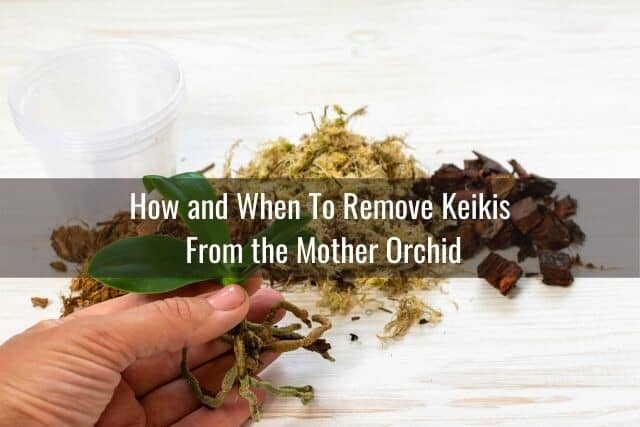
Dealing with keikis is easy once you know how to grow them. However, you wouldn’t want to work for weeks or months, growing and nurturing your orchid keiki, just to watch it die after you separate it from the mother orchid. Here are some tips to ensure you have success with your keiki orchids.
Wait Until the Keiki’s Roots Are Two to Three Inches Long and the Keiki Has Two Leaves
If you separate the keiki from the mother plant too early, the keiki’s roots won’t be long enough to absorb water and nutrients. Roots that are too short can be detrimental to the keiki’s growth. It will wither away once you transplant it to its own pot.
Wait until the keiki’s roots are 2 to 3 inches long and the keiki plant has at least two leaves before you try to separate it from the mother plant. When the roots are long enough, you can go on to the next step.
Snip Two Inches Down the Mother Plant’s Spike
Do not cut the keiki’s roots or try to pull the keiki off the orchid stem. Instead, cut off part of the mother orchid’s stem an inch above and below the keiki. Leave the keiki attached to the stem section.
Be sure you treat the cut stem on the mother orchid with an anti-fungal powder such as cinnamon. This will help prevent infection or contamination from happening.
Place the Keiki in a New Pot With Potting Media
Once you have carefully removed the keiki along with a portion of the mother’s stem, plant the keiki along with the attached piece of stem. Use a new pot with nutrient-rich potting media.
When positioning the keiki in the pot, try to extend the roots, so they point down into the potting media. Roots that are curled around the mother spike will not be able to absorb enough water. Rather than keeping the roots concentrated in a small area, be sure you gently spread them out into the potting media.
Cover the top of the potting media and the area around the keiki roots with damp sphagnum moss. This will help maintain humidification and moisture for your baby orchid.
Mist the Keiki Daily
Throughout the growing process, you will have to mist the keikis to keep them hydrated and maintain humidity levels. Some people prefer to use aloe vera water to add nutrients. Whatever you do, keep the artificial supplements to a minimum to prevent caking.
Adjust the Temperature and Humidity
Get a thermometer and hygrometer if you do not have one already. While not mandatory, these tools will be very useful for helping you maintain the right environment for your keikis.
The thermometer and hygrometer will show you the temperature and humidity of your growing area. You can make adjustments if your growing area is outside the recommended parameters, which is 65 to 75°F (18 to 24°C) and 60% to 90% humidity.
Damp sphagnum moss will increase ambient humidity naturally if you do not want to use a humidifier.
Please be aware that you will not notice immediate growth when you plant the orchids. It takes time, so do not feel discouraged if your orchid keikis are not sprouting flowers and setting roots right away. If you want to know how long it takes for roots to grow, keep reading.
How Long Does It Take Orchid Keikis to Grow Roots?

Growing keikis and transplanting them to new gardening pots are only half of the work. You will still have to wait and maintain them for a while before more roots grow. Without healthy, hydrated roots, your orchid keikis will not grow or produce flowers. Here is how long it takes for them to grow:
- It takes between six to twelve months for orchid keikis to grow roots. Contrary to popular belief, not all plants grow roots quickly. Keikis might develop on the mother orchid in a few weeks, but it can take up to one year for them to sprout their own roots.
- Wait until the roots are long enough (this is more important than the time span). Rather than waiting for a specific time span, it is crucial that you wait to transplant the orchid keikis until their roots are long enough. Failure to follow this step will lead to wilting and likely cause the keikis to die.
- Never remove an orchid keiki too soon. Even if you have reached the 6-to-12-month window, you still might not be able to separate the keiki from the mother orchid. Measure the roots to ensure they are the minimum length needed for survival, which is at least 2 or 3 inches. Some keikis have short roots around 2 inches, which is long enough. As long as the roots are long enough to go into the soil, you’re good to go.
- Accelerate the process with aloe vera. Aloe vera can be very beneficial for orchids. Orchids can absorb the nutrients quickly, promoting all sorts of growth. If you want your keikis to sprout roots more quickly, rub 1 tablespoon of aloe vera on the roots. You will be surprised by how effective it is. You can buy aloe vera plants and use the cut aloe leaves to get the aloe vera liquid.
- Natural orchid conditions are best for optimal keiki growth. The best way to know how to grow strong, thriving keiki roots is to learn more about the mother orchid’s native environment. If the orchid originates in Africa, then it can likely withstand warm temperatures. On the other hand, South American orchids require less sunlight and more moisture or humidity.
- Keiki paste works to promote root growth. Use this sparingly. Too much paste will limit nutrient and water absorption, but a little bit will help the keiki grow deeper roots.
How Long Does It Take An Orchid Keiki to Flower?

Much like orchid keiki roots take a while to grow, it will also take your keiki plant time to mature enough to develop flowers. Orchids are slow-growing, long-lasting plants. So, how long does it take for the keikis to bloom once you plant them in a pot?
- It typically takes between one to three years for orchid keikis to flower. That’s right; your keikis probably won’t grow flowers within the first year of the transplant. Instead, you might have to wait up to three years to see blooms develop from the keikis. The keiki is an exact clone of the mother plant. The orchid blooms you will see on the keiki will be the same color and look as the blooms on the mother plant.
- Some species flower much quicker than others. Another reason the time frame varies is that some orchid genera grow slower, while others speed through the process. Research your orchids to know how quickly they will flower. The time it takes your keiki to flower will be similar to how long it takes for other orchids in that species.
- Ambient humidity and temperature affect keiki flowering. Dryness, excess moisture, hot or freezing temperatures all affect the blooming process. Keep your keiki safe and comfortable, and watch as it turns into an adult orchid. Eventually, it may be able to sprout keikis of its own.
- Orchid keikis often take longer to grow than the mother plants. Since they are sometimes growing from suboptimal conditions, you will have to wait a bit longer for blooms than you did with the original orchid. This process is natural, so don’t be concerned if the keiki’s mother plant develops blooms more quickly than the keiki.
- Don’t stress if it is not flowering within the provided time table. As mentioned earlier, some keikis take a little bit longer to grow than you might think. Varying conditions, mother plants, genera, and many other factors influence the growth rate. If you are doing everything you can and following the previously mentioned steps, your keikis will sprout and flower in due time. Just be patient.
Final Thoughts
Orchid keikis might look adorable, but you should treat them as if they were a new plant with specific needs. Failure to follow the steps and suggestions mentioned throughout this article can cause harm to the keiki and its mother plant.
Orchid keikis should be seen as much more fragile than mother plants. This is because they originated from another orchid rather than the soil or a seed. Growing keikis requires attention to detail but it can be a very rewarding process. Happy orchid growing!
If you enjoyed this article, please pin it and share!


